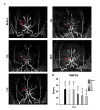A Reliable Nonhuman Primate Model of Ischemic Stroke with Reproducible Infarct Size and Long-term Sensorimotor Deficits
- PMID: 36818571
- PMCID: PMC9937702
- DOI: 10.14336/AD.2022.0722
A Reliable Nonhuman Primate Model of Ischemic Stroke with Reproducible Infarct Size and Long-term Sensorimotor Deficits
Abstract
A nonhuman primate model of ischemic stroke is considered as an ideal preclinical model to replicate various aspects of human stroke because of their similarity to humans in genetics, neuroanatomy, physiology, and immunology. However, it remains challenging to produce a reliable and reproducible stroke model in nonhuman primates due to high mortality and variable outcomes. Here, we developed a focal cerebral ischemic model induced by topical application of 50% ferric chloride (FeCl3) onto the MCA-M1 segment through a cranial window in the cynomolgus monkeys. We found that FeCl3 rapidly produced a stable intraarterial thrombus that caused complete occlusion of the MCA, leading to the quick decrease of the regional cerebral blood flow in 10 min. A typical cortical infarct was detected 24 hours by magnetic resonance imaging (MRI) and was stable at least for 1 month after surgery. The sensorimotor deficit assessed by nonhuman primate stroke scale was observed at 1 day and up to 3 months after ischemic stroke. No spontaneous revascularization or autolysis of thrombus was observed, and vital signs were not affected. All operated cynomolgus monkeys survived. Our data suggested that FeCl3-induced stroke in nonhuman primates was a replicable and reliable model that is necessary for the correct prediction of the relevance of experimental therapeutic approaches in human beings.
Keywords: cynomolgus macaque; ferric chloride; ischemic stroke; middle cerebral artery; nonhuman primate.
copyright: © 2022 Lin et al.
Conflict of interest statement
Conflicts of Interest The authors declare no conflict of interest.
Figures



Similar articles
-
Nonhuman primate models of ischemic stroke and neurological evaluation after stroke.J Neurosci Methods. 2022 Jul 1;376:109611. doi: 10.1016/j.jneumeth.2022.109611. Epub 2022 Apr 26. J Neurosci Methods. 2022. PMID: 35487315 Review.
-
Chronic ischemic stroke model in cynomolgus monkeys: behavioral, neuroimaging and anatomical study.Neurol Res. 2003 Jan;25(1):68-78. doi: 10.1179/016164103101200950. Neurol Res. 2003. PMID: 12564129
-
Impaired Arm Function and Finger Dexterity in a Nonhuman Primate Model of Stroke: Motor and Cognitive Assessments.Stroke. 2016 Apr;47(4):1109-16. doi: 10.1161/STROKEAHA.115.012506. Epub 2016 Mar 8. Stroke. 2016. PMID: 26956259
-
Therapeutic time window of tacrolimus (FK506) in a nonhuman primate stroke model: comparison with tissue plasminogen activator.Exp Neurol. 2007 Mar;204(1):138-46. doi: 10.1016/j.expneurol.2006.10.003. Epub 2006 Dec 13. Exp Neurol. 2007. PMID: 17169359
-
Selection of preclinical models to evaluate intranasal brain cooling for acute ischemic stroke.Brain Circ. 2019 Dec 27;5(4):160-168. doi: 10.4103/bc.bc_20_19. eCollection 2019 Oct-Dec. Brain Circ. 2019. PMID: 31950091 Free PMC article. Review.
Cited by
-
Age-Related Dysfunction in Balance: A Comprehensive Review of Causes, Consequences, and Interventions.Aging Dis. 2024 Jan 24;16(2):714-737. doi: 10.14336/AD.2024.0124-1. Aging Dis. 2024. PMID: 38607735 Free PMC article. Review.
-
Hydrogel-based biomaterials for brain regeneration after stroke: Gap to clinical translation.Biomater Transl. 2025 Jun 25;6(2):165-180. doi: 10.12336/bmt.24.00020. eCollection 2025. Biomater Transl. 2025. PMID: 40641992 Free PMC article. Review.
-
Greater Omentum: Multifaceted Interactions in Neurological Recovery and Disease Progression.Aging Dis. 2024 Feb 19;15(6):2381-2394. doi: 10.14336/AD.2024.0213. Aging Dis. 2024. PMID: 38421824 Free PMC article. Review.
-
Combination of Atractylenolide I, Atractylenolide III, and Paeoniflorin promotes angiogenesis and improves neurological recovery in a mouse model of ischemic Stroke.Chin Med. 2024 Jan 4;19(1):3. doi: 10.1186/s13020-023-00872-z. Chin Med. 2024. PMID: 38178130 Free PMC article.
-
The link between sleep duration and stroke risk.Brain Circ. 2025 Mar 21;11(1):1-8. doi: 10.4103/bc.bc_7_24. eCollection 2025 Jan-Mar. Brain Circ. 2025. PMID: 40224552 Free PMC article.
References
LinkOut - more resources
Full Text Sources
